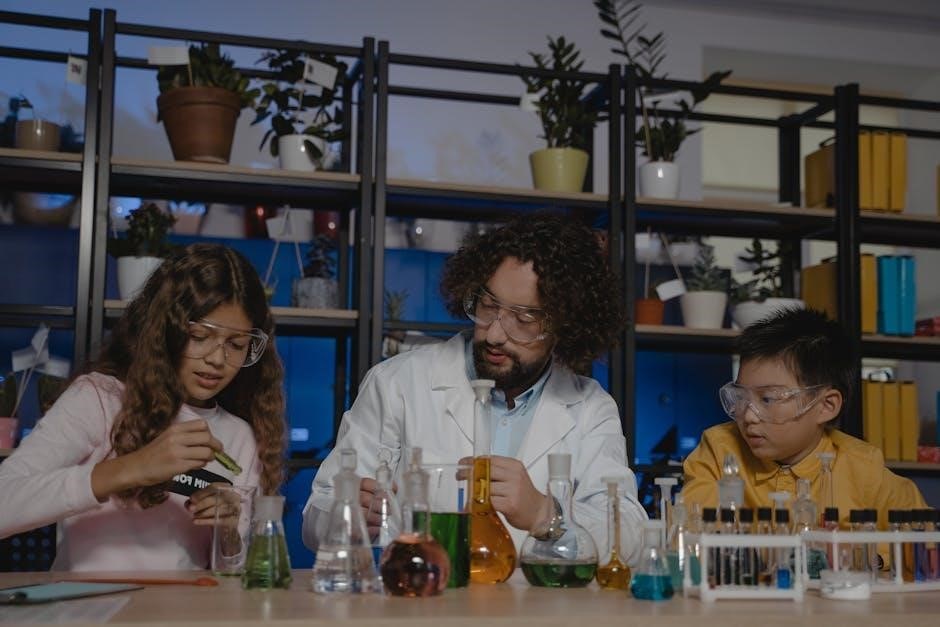relationships and biodiversity lab teacher guide
The introduction to relationships and biodiversity lab teacher guide provides essential information and resources for educators to effectively teach students about biodiversity and classification concepts clearly․
Overview of the Lab Guide
The relationships and biodiversity lab teacher guide is a comprehensive resource designed to support educators in teaching students about biodiversity and classification concepts․ The guide provides a detailed overview of the lab activities, including the materials and supplies needed, and offers practical suggestions for implementation․ According to the Internet, the guide is approximately 20 pages long and includes helpful pictures, tables, and diagrams to facilitate student understanding․ The lab guide is suitable for students in grades 9-12 and covers essential topics in biology and environment․ The guide is intended to help both teachers and students navigate the lab activities with ease, promoting a deeper understanding of relationships and biodiversity․ The overview of the lab guide serves as a foundation for the rest of the resource, providing a clear and concise introduction to the subject matter․

Lab Activity 1 ‒ Relationships and Biodiversity
Lab activity introduces students to classification and biodiversity concepts clearly and effectively always․
Classification and Biodiversity
Classification and biodiversity are closely related concepts in the context of the relationships and biodiversity lab teacher guide․ Organisms are classified according to their physical and chemical characteristics, which helps to understand their relationships and interactions with each other․ The classification system used in the lab is based on the similarities and differences between organisms, and it provides a framework for understanding the diversity of life on Earth․ By studying classification and biodiversity, students can gain a deeper understanding of the complex relationships between different species and their environments․ The lab guide provides resources and activities to help students learn about classification and biodiversity, including diagrams, tables, and interactive exercises․ These resources are designed to support student learning and help teachers to effectively teach the concepts of classification and biodiversity․ The guide is suitable for students in grades 9-12․

Lab Materials and Supplies
Lab materials and supplies include a Relationships and Biodiversity Lab Kit per group with necessary equipment and resources for students to conduct experiments and activities successfully always․
Relationships and Biodiversity Lab Kit
The Relationships and Biodiversity Lab Kit is a comprehensive package designed to support the lab activities and experiments outlined in the teacher guide․ This kit includes all the necessary materials and equipment for students to engage in hands-on learning experiences, exploring the concepts of classification and biodiversity․ The kit is available for purchase through Ward Science, although it is noted that the kits are overpriced․ Despite this, the kit provides a convenient and efficient way for educators to acquire the necessary supplies for the lab, ensuring that students have access to the resources they need to complete the activities and achieve the learning objectives․ The kit is an essential component of the lab, allowing students to develop a deeper understanding of the relationships between different organisms and the importance of biodiversity․

Teacher Support and Resources
Teacher support and resources are available to assist educators in implementing the lab effectively always with helpful guides and materials provided online clearly․
Answer Key and Visual Aids
The answer key and visual aids are essential components of the relationships and biodiversity lab teacher guide, providing teachers with a comprehensive resource to support student learning․
The answer key includes detailed explanations and examples to help teachers assess student understanding and provide feedback․
Visual aids such as diagrams, charts, and graphs are also included to help illustrate complex concepts and make the material more engaging for students․
These resources can be used to support a variety of teaching methods and can be adapted to meet the needs of different learners․
By using the answer key and visual aids, teachers can help students develop a deeper understanding of relationships and biodiversity concepts and promote critical thinking and problem-solving skills․
Overall, the answer key and visual aids are valuable tools for teachers to support student learning and achievement in the relationships and biodiversity lab․
Student Learning Outcomes
Students will understand biodiversity concepts and classification methods clearly and effectively․
Understanding Biodiversity
Understanding biodiversity is a crucial aspect of the relationships and biodiversity lab teacher guide, as it enables students to comprehend the complex interactions between different species and their environments․ The guide provides a comprehensive overview of biodiversity, including its definition, importance, and impact on ecosystems․ By exploring the various levels of biodiversity, such as species, genetic, and ecosystem diversity, students can gain a deeper appreciation for the natural world and the importance of conservation․ The guide also discusses the factors that influence biodiversity, including climate change, habitat destruction, and human activities, and provides strategies for promoting biodiversity and sustainability․ Through interactive activities and real-world examples, students can develop a thorough understanding of biodiversity and its significance in maintaining healthy and resilient ecosystems, which is essential for their future careers and personal lives as responsible citizens․
Implementation and Assessment
Effective implementation and assessment strategies are crucial for successful relationships and biodiversity lab teacher guide execution and evaluation always matters greatly online․
Lab Guide Structure
The lab guide structure is designed to provide a clear and comprehensive outline for teachers to follow, ensuring a successful and engaging learning experience for students;
The structure includes an introduction to the lab, followed by a series of activities and exercises that promote hands-on learning and critical thinking․
Each section of the guide is carefully organized to build on previous concepts, allowing students to develop a deeper understanding of relationships and biodiversity․
The guide also includes assessment tools and evaluation criteria, enabling teachers to track student progress and identify areas for improvement․
By following the lab guide structure, teachers can create a supportive and inclusive learning environment that fosters student curiosity and enthusiasm for the subject matter, leading to a more effective and enjoyable learning experience․
The structure is flexible and adaptable, allowing teachers to modify it to suit their specific needs and teaching styles․

and Future Directions
The guide concludes with future directions for teaching relationships and biodiversity effectively always․
Expanding the Lab Experience
To expand the lab experience, educators can incorporate additional activities and resources that promote student engagement and understanding of relationships and biodiversity concepts․
This can include inviting guest speakers, conducting field trips, and utilizing online resources and educational games․
By providing students with a comprehensive and interactive learning experience, educators can help students develop a deeper appreciation and understanding of the importance of biodiversity and classification․
The lab experience can also be expanded to include real-world applications and case studies, allowing students to see the practical relevance of the concepts they are learning․
This can help to motivate students and encourage them to pursue further study and careers in fields related to biology and environmental science, with a focus on relationships and biodiversity always․










Leave a Comment